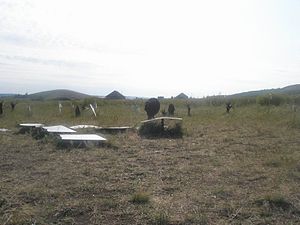 |
| Arkaim is a mysterious site in formerly Buddhist Central Asia little known in the west (AC). |
 |
| Winter Solstice: the shortest day of the year, Dec. 21, 2015 (timeanddate.com) |
Ancient Hindu City
Arkaim (Russian Аркаим) is an archeological site situated in the Southern Urals steppe, 8.2 km (5.1 miles) north-northwest of the village of Amurskiy and 2.3 km (1.4 mi) south-southeast of the village of Alexandrovskiy, in the Chelyabinsk Oblast, Russia, just north of the Kazakhstan border.
The site is generally dated to the 17th century BCE. Earlier dates, up to the 20th century BCE, have been proposed. It was a settlement of the Sintashta-Petrovka culture.
Discovery and excavation
The site was discovered in 1987 by a team of Chelyabinsk scientists who were preparing the area to be flooded in order to create a reservoir, and examined in rescue excavations led by Gennadii Zdanovich.
At first their findings were ignored by Soviet authorities, who planned to flood the site as they had flooded Sarkel earlier, but the attention attracted by news of the discovery forced the Soviet government to revoke its plans for flooding the area. It was designated a cultural reservation in 1991, and in May 2005 the site was visited by Pres. Vladimir Putin.
Settlement
The settlement covered ca. 20,000 m2 (220,000 sq ft). The diameter of the enclosing wall was 160 m (520 ft). It was built from earth packed into timber frames, and reinforced with unburned clay brick, with a thickness of 4-5 m (13-16 ft). and a height of 5.5 m (18 ft). The settlement was surrounded with a 2 m (6 ft 7 in)-deep moat.
The inner ring of dwellings number 27, arranged along the inner wall, with doors to the central square of 25 by 27 m (82 by 89 ft). The central street was drained by a covered channel. Zdanovich estimates that approximately 1,500 to 2,500 people could have lived in the settlement.
Surrounding Arkaim's walls, were arable fields, 130-140 m by 45 m (430-460 ft by 150 ft), irrigated by a system of canals and ditches. Remains of millet and barley seeds were found.
The 17th century BCE date suggests that the settlement was about co-eval to, or just post-dating, the alleged (and strongly debated) Indo-Aryan migration into South Asia and Mesopotamia. The Gandhara grave culture appeared in modern Northern Pakistan (formerly northwest India up until 1948).
- Winter Solstice: The Sun Stands Still
- Saturn and the Moon Shine at Dawn Friday as Winter Solstice Looms
- Ring in the New Season; December Solstice
- Earth's extreme tilt marks the winter solstice: Discovery News...A Bolivian indigenous man raises his hands to receive the first beam of the rising sun during the winter solstice ceremony in Tiahunaco.
Since its discovery, Arkaim has attracted public and media attention in Russia, from a broad range of the population, including a significant number of esoteric, New Age and pseudoscientific organizations (А.М. Кисленко, "Что такое Аркаим?").
One of the major researchers of Arkaim, Fyodor Petrov, acknowledged that he uncritically and non-scientifically supported the neopaganist views on Arkaim. His confession was published as an afterword to the book by Andrey Gupalo (Андрей Гупало «Духовное поле Аркаима»), which, in part, detailed how the archaeological results were "dovetailed" into the neopagan and esoteric theories [Fyodor Petrov, Наука и неоязычество на Аркаиме ("Science and Neopaganism at Arkaim")].
A popular comedian Mihail Zadornov made a pseudoscientific film "Arkaim. Standing by the Sun" ("Аркаим. Стоящий у Солнца"), in which data resembling earlier Zdanovich's documentaries of 1993 – "The fire of Arkaim" ("Огонь Аркаима"), 1995 and 2005 were interpreted, mixed with anti-West ideas.
Swastika City
In order to gain publicity, the early investigators described Arkaim as "the ancient capital of early Aryan civilization, as described in the [Iranian] Avesta and [Indus Valley Civilization] Vedas," "Swastika City" and "Mandala City."
The swastika description refers to the floor plan of the site, which (with some imagination) may appear similar to the swastika symbol, albeit with rounded arms (similar to the lauburu) attached to a central ring instead of a cross. More


























































































































































































































































No comments:
Post a Comment